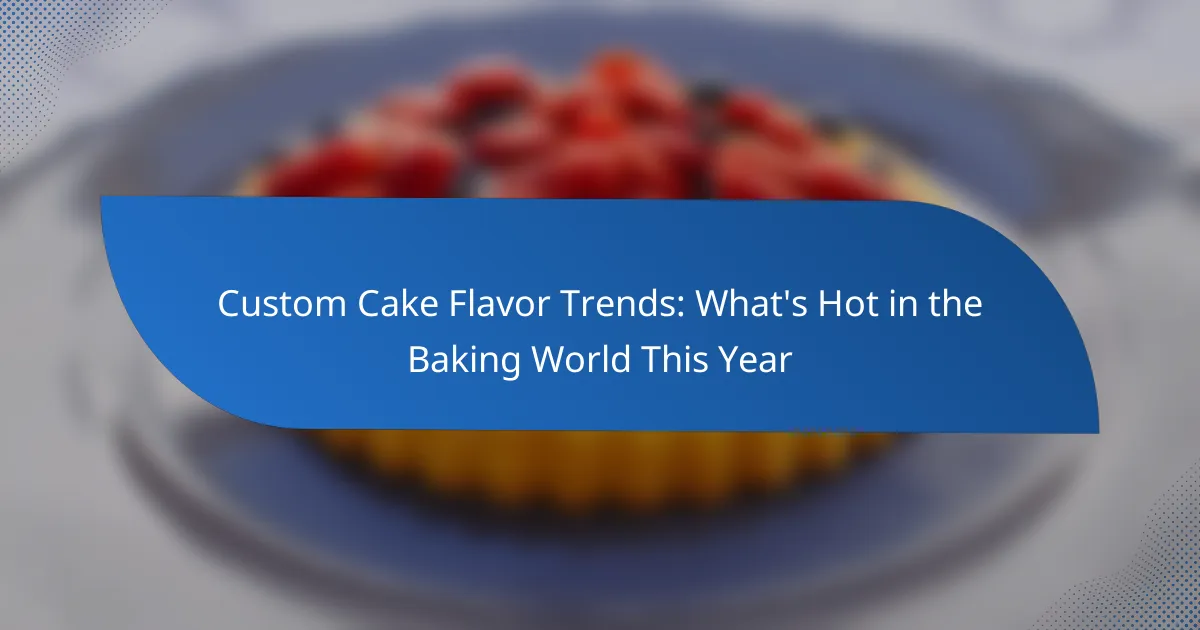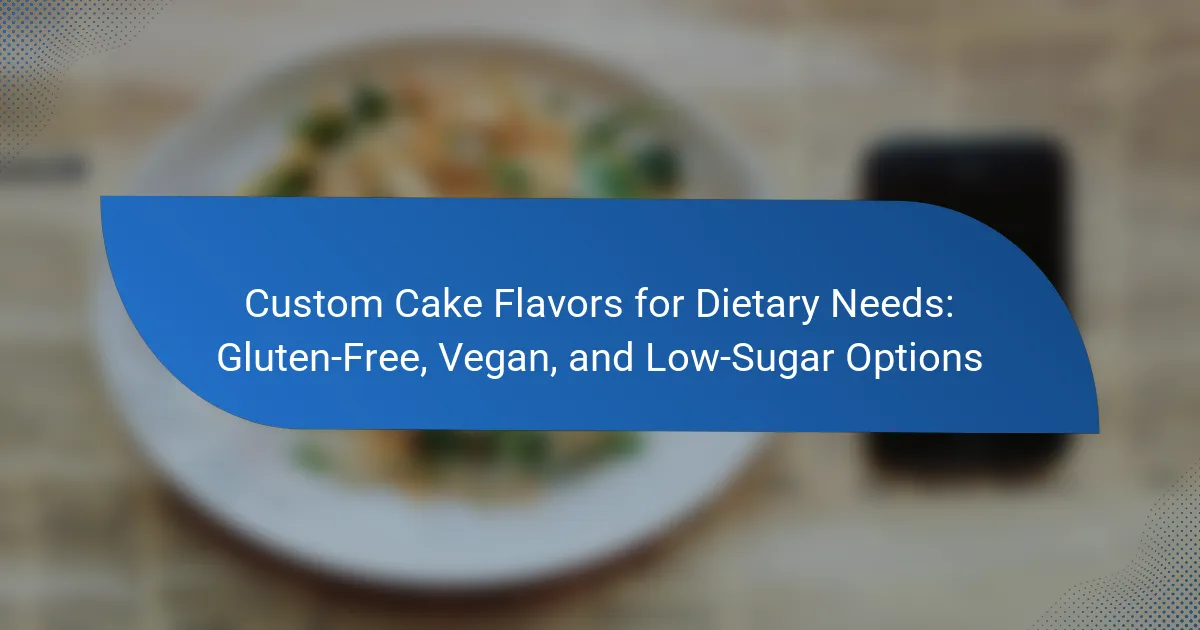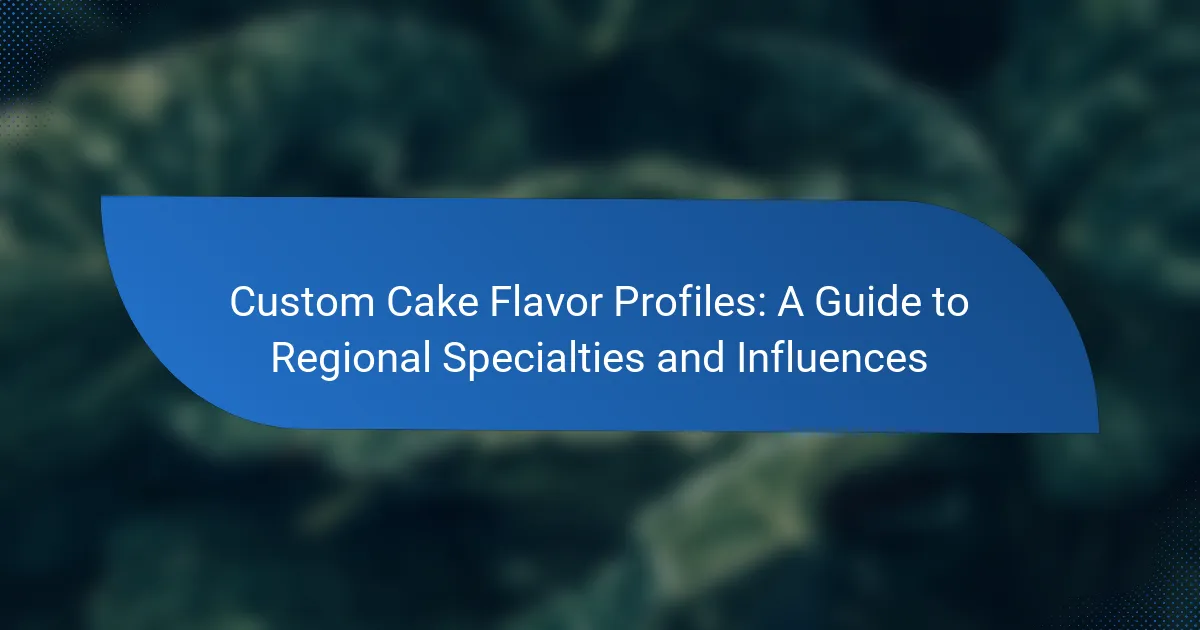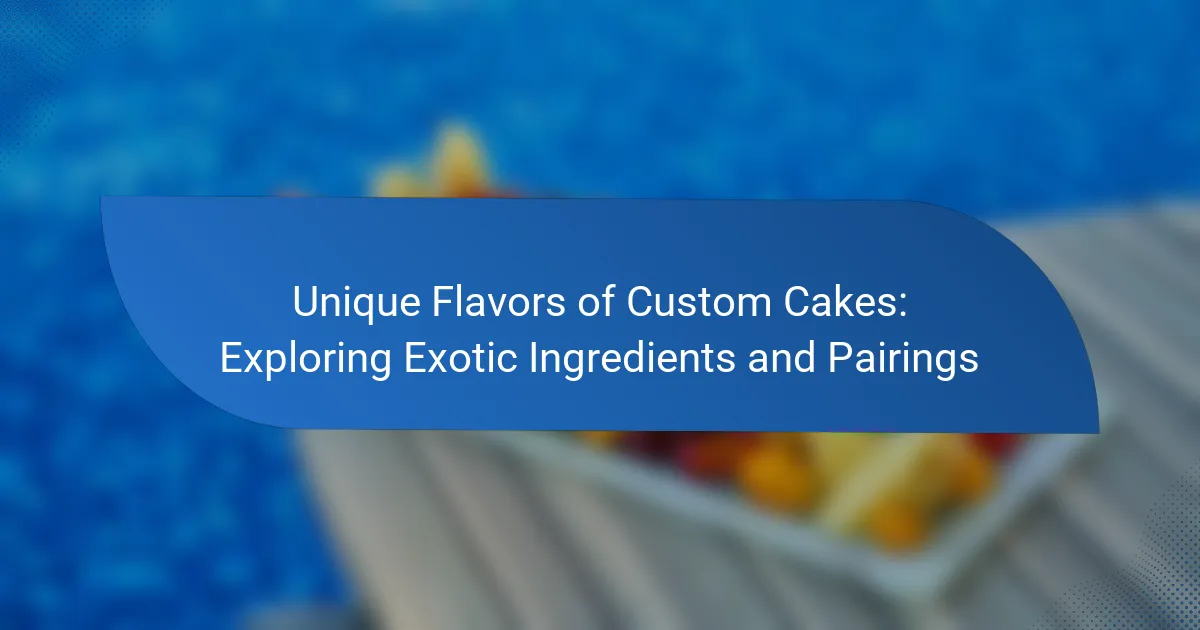Custom cake flavors represent unique, personalized tastes that extend beyond traditional options like chocolate and vanilla, incorporating creative combinations such as lavender lemon or chai spice. Bakers often tailor these flavors to client preferences, enhancing the overall experience of special occasions. The article covers techniques for balancing sweetness through complementary flavors and ingredient adjustments, as well as the importance of achieving moist and fluffy textures in custom cakes. Additionally, it emphasizes the significance of stunning presentation through design, color, and texture, ensuring that custom cakes not only taste exceptional but also serve as impressive centerpieces.
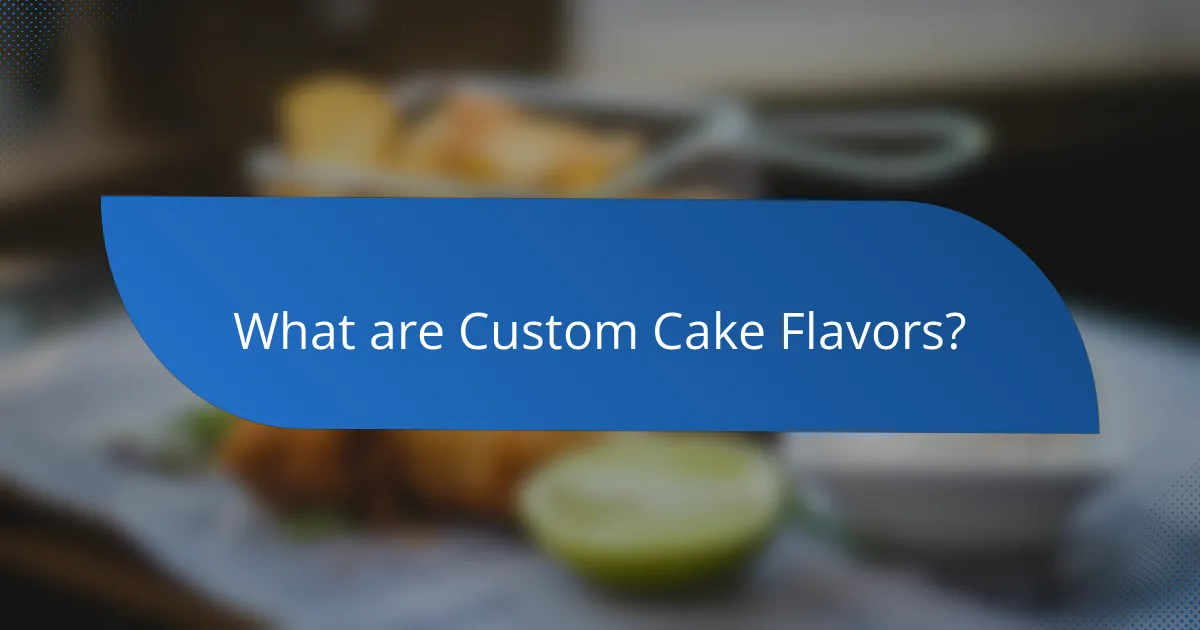
What are Custom Cake Flavors?
Custom cake flavors are unique, personalized tastes created for cakes. They go beyond traditional flavors like chocolate or vanilla. Custom flavors can include combinations such as lavender lemon or chai spice. Bakers often develop these flavors based on client preferences. Custom cake flavors allow for creativity and individual expression in dessert design. They can enhance the overall experience of special occasions. Many bakeries offer consultations to create tailored flavor profiles. This approach ensures that the cake meets specific taste requirements and complements the event theme.
How do custom cake flavors differ from traditional flavors?
Custom cake flavors differ from traditional flavors by offering unique combinations and innovative ingredients. Traditional flavors often include vanilla, chocolate, and red velvet. Custom flavors can incorporate spices, fruits, or even savory elements. This allows for greater creativity and personalization. Custom cakes cater to specific tastes and dietary restrictions. For example, gluten-free or vegan options can be made with alternative ingredients. This flexibility is not typically found in standard flavor profiles. Additionally, custom cakes can reflect themes or occasions, enhancing the overall experience. The growing trend of custom cakes reflects consumer desire for individuality in dessert choices.
What are the key characteristics of custom cake flavors?
Custom cake flavors are defined by their unique combinations of ingredients and taste profiles. They often feature a balance of sweetness and richness. Common characteristics include diverse flavor bases such as vanilla, chocolate, or fruit. Additional elements like spices or extracts enhance complexity. Texture plays a crucial role, with options ranging from moist and fluffy to dense and fudgy. Customization allows for personal preferences, including dietary restrictions or flavor pairings. Each flavor can be tailored to suit specific occasions or themes. This versatility makes custom cakes popular for celebrations.
Why are custom cake flavors becoming popular?
Custom cake flavors are becoming popular due to increasing consumer desire for personalization. People seek unique experiences that reflect their tastes and preferences. This trend aligns with the growing culture of customization in food. According to a study by the National Confectioners Association, 73% of consumers prefer personalized treats for special occasions. Additionally, social media platforms amplify the visibility of creative cake designs and flavors. This encourages bakers to innovate and offer diverse flavor options. As a result, custom cakes cater to dietary restrictions and flavor preferences, enhancing their appeal.
What factors influence the creation of custom cake flavors?
The creation of custom cake flavors is influenced by several key factors. Ingredients play a crucial role in flavor development. The choice of base cake, such as vanilla or chocolate, impacts the final taste. Flavor combinations are also significant; pairing complementary flavors can enhance the overall profile. Seasonal ingredients can inspire unique flavors, aligning with freshness and availability. Customer preferences guide flavor selection, ensuring the cake meets specific tastes. Cultural influences can shape flavor choices, reflecting traditional or regional favorites. Lastly, dietary restrictions may necessitate alternative ingredients, affecting flavor profiles.
How does sweetness impact the overall flavor profile?
Sweetness significantly influences the overall flavor profile of food. It can enhance or mask other flavors present in a dish. Sweetness often balances acidity and bitterness, creating a more harmonious taste. For example, in cakes, a higher sugar content can soften sharp flavors like citrus or chocolate. Additionally, sweetness can evoke positive emotional responses, making the food more enjoyable. Research shows that sweetness perception activates reward pathways in the brain, reinforcing its appeal. Therefore, the level of sweetness is crucial in crafting a well-rounded flavor experience in custom cakes.
What role does texture play in custom cake flavors?
Texture significantly influences the overall experience of custom cake flavors. It affects how flavors are perceived on the palate. A cake’s texture can range from moist and fluffy to dense and crumbly. These variations can enhance or diminish the flavor intensity. For instance, a light, airy texture often amplifies sweet flavors. Conversely, a dense texture may provide a richer, more robust taste.
Furthermore, texture contributes to the mouthfeel, impacting how enjoyable a cake is to eat. Cakes with contrasting textures, such as a soft sponge paired with crunchy toppings, create a more dynamic experience. Research shows that texture can alter flavor perception by up to 30%. This highlights its crucial role in custom cake design. Therefore, bakers must carefully consider texture when crafting unique flavor profiles.
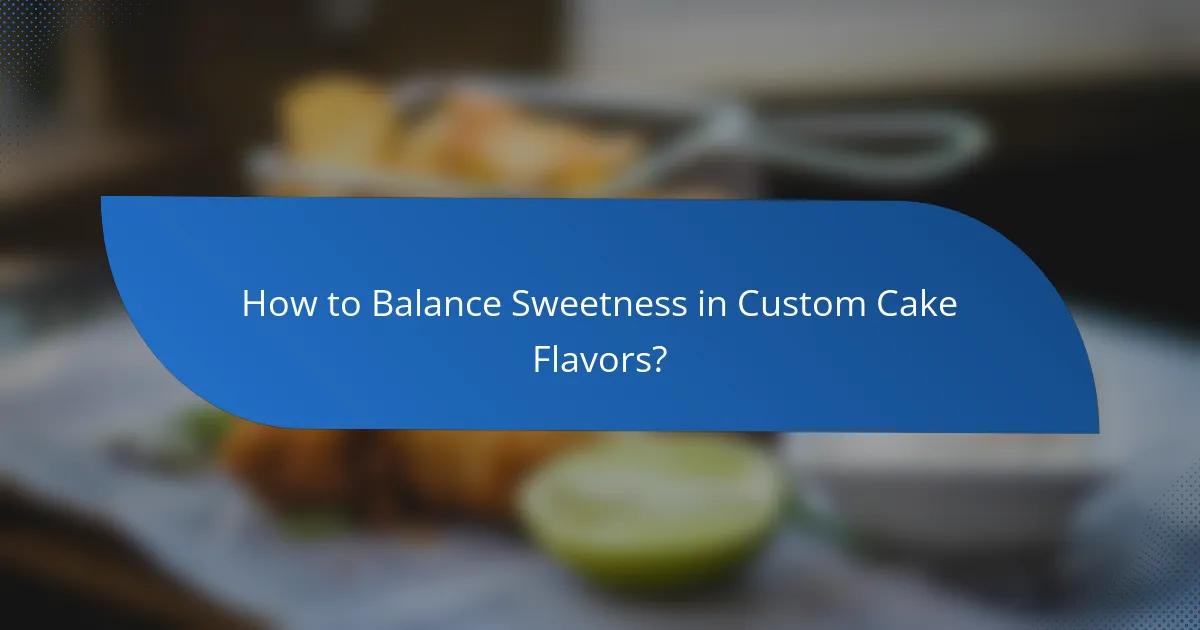
How to Balance Sweetness in Custom Cake Flavors?
To balance sweetness in custom cake flavors, use complementary flavors and adjust sugar levels. Incorporate ingredients like citrus, spices, or salt to counteract sweetness. For example, lemon zest can enhance flavor without adding sugar. Consider using less sweet bases, such as unsweetened cocoa powder in chocolate cakes. Adjusting the sugar content in the batter can also create a more balanced taste. Using natural sweeteners like honey or agave can provide different flavor profiles. Testing small batches allows for fine-tuning sweetness levels. Ultimately, achieving balance enhances the overall flavor experience in custom cakes.
What are the best practices for achieving the right sweetness?
To achieve the right sweetness in custom cake flavors, use a balanced ratio of sugar to other ingredients. This ratio typically ranges from 1 to 2 cups of sugar per cake recipe, depending on the other flavor components. Incorporate natural sweeteners like honey or maple syrup for depth. Consider using flavor enhancers like vanilla or citrus zest to complement sweetness. Monitor the baking time, as underbaking can lead to a less sweet taste. Taste testing during preparation allows for adjustments before finalizing the recipe. Remember that sweetness perception can vary; adjust based on personal preference and target audience.
How can different sweeteners affect the flavor?
Different sweeteners can significantly affect flavor profiles in baked goods. Natural sweeteners like honey and maple syrup contribute unique flavors beyond sweetness. They can add floral or earthy notes, enhancing overall taste complexity. Artificial sweeteners, such as aspartame or sucralose, provide sweetness without additional flavors. These can result in a more one-dimensional taste. Sugar alternatives like agave nectar have a mild flavor but can also impart a slight aftertaste. The choice of sweetener impacts not just sweetness but also texture and moisture. For instance, brown sugar adds moisture and a caramel-like flavor due to its molasses content. Understanding these nuances helps in creating balanced custom cake flavors.
What are common mistakes to avoid in balancing sweetness?
Common mistakes to avoid in balancing sweetness include using too much sugar, which can overpower other flavors. Not considering the sweetness of other ingredients, like fruits or chocolate, can lead to an unbalanced taste. Failing to taste and adjust during the baking process often results in overly sweet cakes. Additionally, neglecting to account for the final texture can affect the perception of sweetness. Using artificial sweeteners without understanding their impact can also lead to unexpected results. Lastly, overlooking the importance of acidity can prevent a well-rounded flavor profile.
How does flavor pairing enhance sweetness?
Flavor pairing enhances sweetness by combining complementary flavors that amplify the perception of sugar. When certain flavors, such as citrus or spice, are paired with sweet ingredients, they create a balanced taste experience. This balance can make the sweetness more pronounced. For instance, adding a hint of salt can enhance sweetness through contrast. Research indicates that salt can increase the perception of sweetness by activating taste receptors. Additionally, pairing sweet flavors with acidity can provide a refreshing contrast, making the sweetness stand out more. This technique is commonly used in desserts, where flavors like lemon or raspberry elevate the overall sweetness.
What are some popular flavor combinations for cakes?
Popular flavor combinations for cakes include chocolate and raspberry, lemon and blueberry, and vanilla and almond. Chocolate pairs well with raspberry for a rich and tart experience. Lemon and blueberry create a refreshing balance of citrus and sweetness. Vanilla and almond enhance the classic flavor with a nutty undertone. Other combinations are red velvet with cream cheese frosting and carrot with cream cheese. These pairings are widely enjoyed and frequently featured in bakeries.
How do complementary flavors affect sweetness perception?
Complementary flavors enhance sweetness perception by creating a more balanced taste experience. When flavors such as salt, acidity, or bitterness are present, they can elevate the overall sweetness of a dish. This phenomenon occurs because these flavors can mask or counteract the perception of excessive sweetness. For example, a pinch of salt can amplify the sweetness in chocolate, making it taste richer. Research shows that pairing sweet flavors with acidic ones, like lemon in a cake, can also enhance the perception of sweetness without increasing sugar content. This technique is commonly used in culinary practices to achieve a more complex flavor profile.
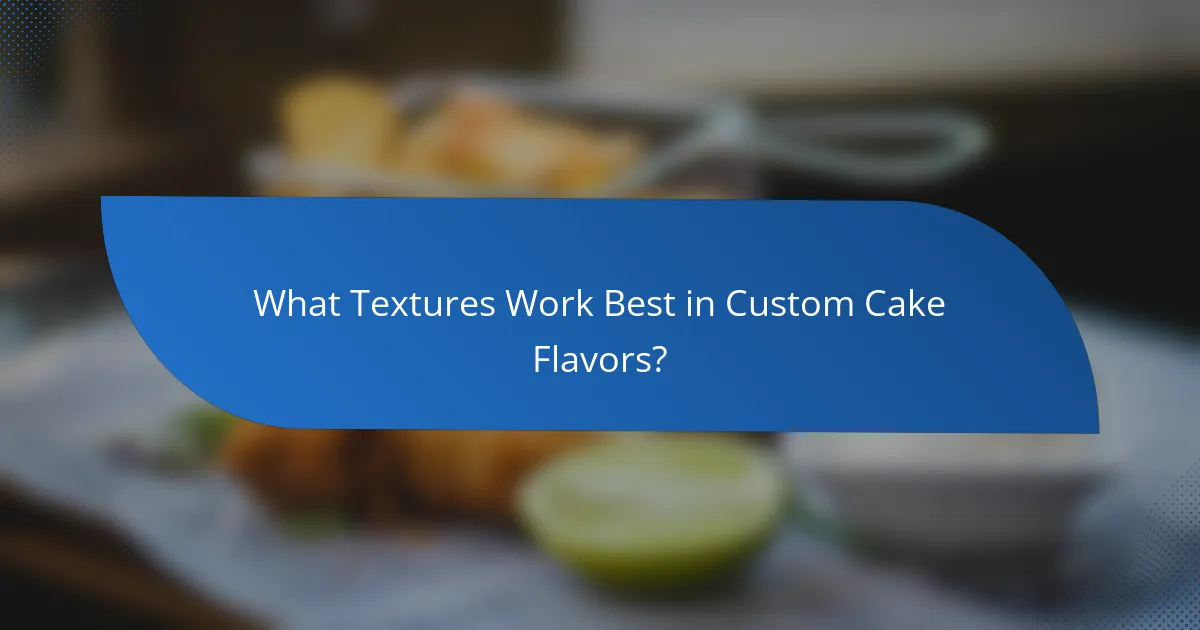
What Textures Work Best in Custom Cake Flavors?
Moist and fluffy textures work best in custom cake flavors. These textures enhance the overall taste experience. A moist cake retains flavor and provides a pleasant mouthfeel. Fluffy textures create a light and airy sensation. Dense textures can also be effective, offering a rich and satisfying bite. Combining textures can create complexity. For instance, a moist cake with a crunchy topping adds contrast. Incorporating fillings, like creamy or fruity layers, can enhance texture diversity. These combinations are popular in custom cake design.
How can texture influence the overall cake experience?
Texture significantly influences the overall cake experience by affecting mouthfeel and flavor perception. A cake’s texture can range from moist and fluffy to dense and crumbly. Moist cakes provide a tender bite, enhancing enjoyment. Fluffy textures create a light sensation, often associated with celebration cakes. Dense textures can evoke richness, making them ideal for indulgent flavors. Crunchy elements, like nuts or crusts, add contrast and complexity. Each texture interacts with sweetness, altering how flavors are perceived. Research indicates that texture can enhance flavor intensity. For instance, a study by the University of Florida found that texture impacts the perception of sweetness and overall flavor satisfaction. This demonstrates that texture plays a crucial role in the cake-eating experience.
What are the different textures used in custom cakes?
Custom cakes can feature various textures. Common textures include smooth, crumbly, fluffy, dense, and moist. Smooth textures are often achieved with buttercream or fondant. Crumbly textures can come from certain cake recipes or ingredients like nuts. Fluffy textures are typically a result of well-aerated batter. Dense textures may be found in pound cakes or mud cakes. Moist textures are important for flavor and can be enhanced with syrups or fillings. Each texture contributes to the overall experience of the cake.
How does texture interact with sweetness in cakes?
Texture influences the perception of sweetness in cakes. A denser texture can enhance sweetness, making flavors more pronounced. Conversely, a lighter texture may diminish the perceived sweetness. This interaction occurs because texture affects mouthfeel and how flavors are released. Creamy textures often feel sweeter due to their smoothness. In contrast, grainy textures can make sweetness seem less intense. Research indicates that the balance of texture and sweetness impacts overall flavor experience. A study published in the Journal of Sensory Studies found that texture significantly alters sweetness perception in baked goods.
What techniques can be used to create varied textures?
Techniques to create varied textures in cakes include using different mixing methods, incorporating various ingredients, and applying diverse baking techniques. For instance, creaming butter and sugar results in a light, airy texture. Folding in whipped egg whites can create a fluffy and delicate structure. Adding ingredients like nuts or chocolate chips introduces crunchiness. Using buttermilk or yogurt can add moisture and tenderness. Baking at varying temperatures can also affect the texture; higher temperatures can create a crust while lower temperatures keep the inside soft. Each of these techniques contributes distinct textures, enhancing the overall cake experience.
How do baking methods affect cake texture?
Baking methods significantly influence cake texture. Different techniques such as creaming, folding, and mixing affect the incorporation of air and moisture. For instance, the creaming method creates a light and airy texture by incorporating air into butter and sugar. In contrast, the mixing method may lead to a denser cake due to less aeration.
The temperature of the oven also plays a crucial role. A higher temperature can create a crustier exterior, while a lower temperature allows for even baking and a softer texture. Additionally, baking time affects moisture retention. Overbaking can result in a dry texture, while underbaking may yield a gooey consistency.
Research indicates that the choice of baking pan can impact heat distribution, further influencing the final texture. For example, metal pans conduct heat better than glass, leading to variations in browning and moisture retention. Therefore, the baking method selected directly affects the cake’s final texture.
What ingredients contribute to unique textures in cakes?
Flour, sugar, fats, eggs, and leavening agents contribute to unique textures in cakes. Different types of flour, such as all-purpose or cake flour, affect the cake’s density. Sugar adds moisture and tenderness, influencing the final crumb structure. Fats, like butter or oil, provide richness and can create a tender texture. Eggs contribute to structure and moisture, impacting the cake’s overall stability. Leavening agents, such as baking powder or baking soda, create air pockets, resulting in a lighter texture. The combination of these ingredients determines the cake’s final mouthfeel and appearance.
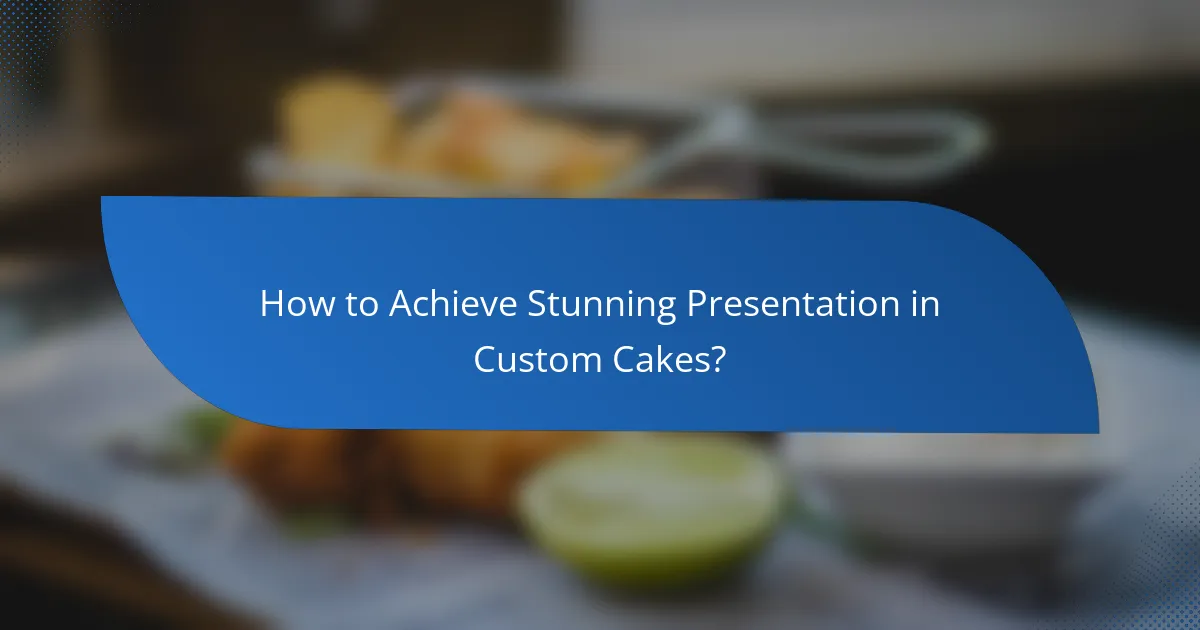
How to Achieve Stunning Presentation in Custom Cakes?
To achieve stunning presentation in custom cakes, focus on design, color, and texture. Use high-quality ingredients to enhance visual appeal. Incorporate contrasting colors for an eye-catching effect. Utilize decorative techniques like fondant, edible flowers, and intricate piping. Ensure even layers for a polished look. Select appropriate cake stands to elevate the presentation. Add finishing touches like glazes or edible glitter. These practices create an impressive visual impact, making the cake a centerpiece.
What are the essential elements of cake presentation?
The essential elements of cake presentation include visual appeal, color contrast, texture, and garnishing. Visual appeal is crucial as it creates the first impression. Color contrast enhances the cake’s aesthetics, making it more inviting. Texture adds depth and interest to the presentation. Garnishing, such as fruits or edible flowers, elevates the overall look. The arrangement of the cake on the serving plate also matters. A clean, well-defined space around the cake allows it to stand out. Lastly, proper lighting can accentuate the cake’s features. These elements work together to create an enticing presentation that captures attention.
How does decoration impact the perception of flavor?
Decoration significantly influences the perception of flavor. Visual appeal can enhance taste expectations. Studies show that attractive food presentation can lead to a more positive flavor experience. For example, a well-decorated cake may taste sweeter due to its aesthetic qualities. Research by Spence et al. (2015) indicates that color and form can alter flavor perception. The brain often associates specific colors with certain flavors, impacting overall enjoyment. Thus, decoration plays a crucial role in shaping how flavors are perceived.
What are some popular presentation styles for custom cakes?
Popular presentation styles for custom cakes include tiered, sculpted, and themed designs. Tiered cakes consist of multiple stacked layers, often decorated with intricate details. Sculpted cakes are designed to resemble objects or characters, showcasing creativity and artistry. Themed cakes reflect specific concepts or events, using colors and decorations that align with the theme. Each style enhances the visual appeal of the cake, making it suitable for various occasions. The choice of presentation style can significantly impact the overall impression and enjoyment of the cake.
How can presentation enhance the overall cake experience?
Presentation enhances the overall cake experience by engaging the senses and creating anticipation. A visually appealing cake can stimulate appetite and enhance enjoyment. Studies show that people perceive taste differently based on visual appearance. For instance, a well-decorated cake can lead to higher satisfaction levels. The colors, shapes, and textures contribute to this sensory experience. Elegant presentation can elevate a simple cake into a centerpiece. Attention to detail, such as frosting techniques and garnishes, adds to the overall impression. Ultimately, presentation plays a critical role in how cakes are perceived and enjoyed.
What techniques can improve visual appeal?
Techniques that can improve visual appeal include the use of color contrast, texture variety, and decorative elements. Color contrast enhances visual interest by creating focal points. For example, pairing dark chocolate frosting with bright fruit toppings draws attention. Texture variety adds depth; incorporating smooth ganache with crunchy nuts creates an engaging experience. Decorative elements like edible flowers or intricate piping can elevate the overall presentation. Additionally, using tiered designs provides height and dimension, making cakes more visually striking. Research indicates that visual appeal significantly influences perceived taste, emphasizing the importance of aesthetics in cake design.
How do colors and shapes affect cake presentation?
Colors and shapes significantly influence cake presentation. Bright colors attract attention and evoke emotions. For instance, red and yellow stimulate appetite, while blue can suppress it. Shapes also play a crucial role; geometric designs can convey elegance, while whimsical shapes can suggest fun. Research indicates that visual appeal impacts perceived taste. A study published in the journal “Food Quality and Preference” shows that cakes with vibrant colors are rated higher in taste perception. Therefore, strategic use of colors and shapes enhances overall cake presentation.
What are some practical tips for creating custom cake flavors?
To create custom cake flavors, start by experimenting with various extracts and spices. Common choices include vanilla, almond, and citrus extracts. Incorporate herbs like basil or rosemary for unique profiles. Use different types of sweeteners, such as honey or maple syrup, to alter flavor depth. Consider adding fruits, both fresh and dried, to enhance taste and moisture. Adjust the cake’s fat content with ingredients like yogurt or sour cream for texture variation. Lastly, balance flavors by pairing sweet elements with salt or acidity, ensuring a well-rounded taste. These methods are widely used in culinary practices to develop distinctive cake flavors.
How can experimentation lead to unique flavor profiles?
Experimentation can lead to unique flavor profiles by combining unexpected ingredients. This process allows for the discovery of new taste combinations. For example, pairing savory herbs with sweet elements can create contrasting flavors. Techniques like infusing, reducing, or layering flavors can enhance complexity. Chefs often utilize trial and error to refine their recipes. Historical examples include the creation of chocolate chili desserts, which blend sweetness with heat. Additionally, regional ingredients can introduce distinct characteristics to flavors. Ultimately, experimentation fosters creativity and innovation in flavor development.
What resources are available for inspiration in custom cake creation?
Inspiration for custom cake creation can be found in various resources. Online platforms like Pinterest and Instagram offer a plethora of visual ideas. Baking blogs provide detailed tutorials and unique flavor combinations. Cookbooks dedicated to cake design showcase professional techniques and styles. Local baking classes allow hands-on experience and creative collaboration. Cake decorating competitions highlight innovative designs and trends. Specialty cake shops often share their creations on social media for public inspiration. Additionally, culinary shows on television introduce new concepts and flavor profiles. These resources collectively foster creativity and innovation in custom cake design.
The main entity of the article is custom cake flavors, which are unique and personalized taste profiles created for cakes that extend beyond traditional options. The article explores the differences between custom and traditional flavors, emphasizing the importance of creativity, individual expression, and dietary considerations in cake design. Key characteristics such as sweetness, texture, and presentation are discussed, highlighting how they influence the overall flavor experience and consumer preferences. Additionally, the article provides practical tips for achieving balanced sweetness, varied textures, and stunning visual appeal in custom cakes, making it a comprehensive guide for bakers and cake enthusiasts.
